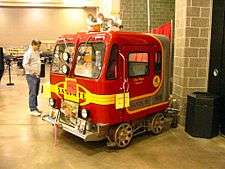Railroad speeder
A speeder (also known as railway motor car, putt-putt, track-maintenance car, crew car, jigger, trike, quad, trolley, inspection car, or a draisine) is a maintenance of way motorized vehicle formerly used on railroads around the world by track inspectors and work crews to move quickly to and from work sites.[1] Although it is slow compared to a train or car, it is called speeder because it is faster than a human-powered vehicle such as a handcar (draisine). Motorised inspection cars date back to at least 1896, when it was reported that the U.S. Daimler Motor Company created a gasoline-powered rail inspection car capable of 15 mph (24 km/h).[2]
In the 1990s, many speeders were replaced with trucks (usually pickup trucks or sport utility vehicles) using flanged wheels that could be lowered for on-rail (called road-rail vehicles or hi-rails for highway-railroad). Speeders are collected by hobbyists, who refurbish them for excursions organized by the North American Railcar Operators Association[3] in the U.S. and Canada and the Australian Society of Section Car Operators, Inc. in Australia.
Motorcar manufacturers and models
U.S.
- Beavercar —
- BMC-2
- BMC-4
- BMC-B
- Buda Manufacturing
- Casey Jones —
- 531
- Fairbanks-Morse
- 40-B
- 101
- 757
- Fairmont Railway Motors Inc
- M14
- S2
- S2-A
- S9,
- S9,
- S9-A
- S9-B
- S9-C
- S9-D
- 1100
- 2100
- 3100
- 4100
- 5100
- 6100
- A2-A8 Series
- M2
- M9
- MT14
- M15
- M17
- M19
- MT19
- S2
- ST2
- C7
- CD7
- CK7
- CR7
Fairmont used three letters to designate car types. "S" was a Standard Series" section car; "A" was an "Advanced Series" section car and "M" was the "Master Series" section car. They also used a "category" name for motorcars. "Light Inspection" or 1-2 men, were car models: M9 nicknamed "Safe Easy", MM9, MR9, 59, M17, and MM17. "Inspection" or 1-4 men, were models "Roadmaster", M12, M16, M19 nicknamed the Safety Quick", MT19, and the 150. "Light Section" or 1-6 men, the M1, and M14 also called the "Light Section Car". "Section" or 1-8 men, were models "Dreadnaught", M2, 75, and S2. "Heavy Duty Section" or 1-8 men, the A2. "Gang" or 1-12 men, MT2, ST2, A2, AT2 and A3. "Extra Gang" or "B & B" 1-12 men, MX3, MX30G, MT2, A4, AF4, and A6. Final group, "Large Extra Gang" or "Hump" 1-12 men, models A6, A7, A8.
- Kalamazoo
- 23 Series B
- 23 Series T
- 27
- 560N
- Portec
- Sheffield
- 40-B
Canada
- Sylvester Steel Products
- "21" section car with "120" engine (steel frame)
- "21E" section car with "KP" engine (aluminum frame)
- "K54" inspection car with "KP" engine (aluminum frame)
- Tamper
- TMC-2
- TMC-6
- TMC-8
- TMC-12
- D Wickham & Co Ltd
- Woodings
- CBI
- CBL
- Railway Workshops
Various railways and their workshops also manufactured speeders. Often these were a copy of commercially available cars, such as Wickham and Fairmont.
Dimensions
Approximate dimensions of a common speeder car are given below. Due to the variety of base models and customization these are not fixed numbers. These values are from a Fairmont A4-D.
- Rail Gauge: 1,435 mm (4 ft 8 1⁄2 in) standard gauge (56.5 inches)
- Weight: 3,500 pounds (1,588 kg)
- Width: 64 inches (1,626 mm)
- Height: 60 inches (1,524 mm)
- Length: 9 feet 2 inches (2,794 mm) (~110 inches)
- Wheel Diameter: 16 inches (406 mm)
- Floor Height: 80–120% of the wheel diameter; 11 inches (279 mm)-17 inches (432 mm)
Gallery
 Speeder in use in Santa Cruz, California
Speeder in use in Santa Cruz, California A privately owned Fairmont MT-14 speeder on display at a model railroad show in February 2004
A privately owned Fairmont MT-14 speeder on display at a model railroad show in February 2004 A former Chessie System speeder at the Linden Railroad Museum, Linden, Indiana
A former Chessie System speeder at the Linden Railroad Museum, Linden, Indiana Former Queensland Rail (Australia) speeders
Former Queensland Rail (Australia) speeders An English Wickham trolley, a railway engineering personnel carrier, used on British Railways as the type No.27 Gang and Inspection trolley from 1946 until the 1990s. Seen at the Amberley Museum Railway on 2 ft (610 mm) gauge.
An English Wickham trolley, a railway engineering personnel carrier, used on British Railways as the type No.27 Gang and Inspection trolley from 1946 until the 1990s. Seen at the Amberley Museum Railway on 2 ft (610 mm) gauge. Fairmont A3D Motorcar - Kentucky and Tennessee Railway #9. It was purchased new by the K&T Rwy in November 1946 and came with an optional Fairmont body and four optional Fairmont seats. It has a four-speed transmission, a forward-reverse transmission and is powered by a Waukesha ICK 17hp 4cyl. gasoline engine.
Fairmont A3D Motorcar - Kentucky and Tennessee Railway #9. It was purchased new by the K&T Rwy in November 1946 and came with an optional Fairmont body and four optional Fairmont seats. It has a four-speed transmission, a forward-reverse transmission and is powered by a Waukesha ICK 17hp 4cyl. gasoline engine.
See also
- Brujita - a motorcycle with wooden platform[5][6][7]
- Draisine
- Handcar
- North American Railcar Operators Association
- Railcar
- Road-rail vehicle
- The Railrodder
References
- "FAQ's & Answers". NARCOA. Retrieved 2008-01-25.
- Notes of the Month, The Automotor and Horesless Carriage Journal, December 1896, p103
- NARCOA website
- Gunner, K., Kennard, M. 2004 The Wickham Works List Dennis Duck Publishing
- Brujita ref 1
- Brujita ref 2
- Brujita ref 3
External links
| Wikimedia Commons has media related to Draisines: (handcars and speeders). |
| Look up railroad speeder in Wiktionary, the free dictionary. |